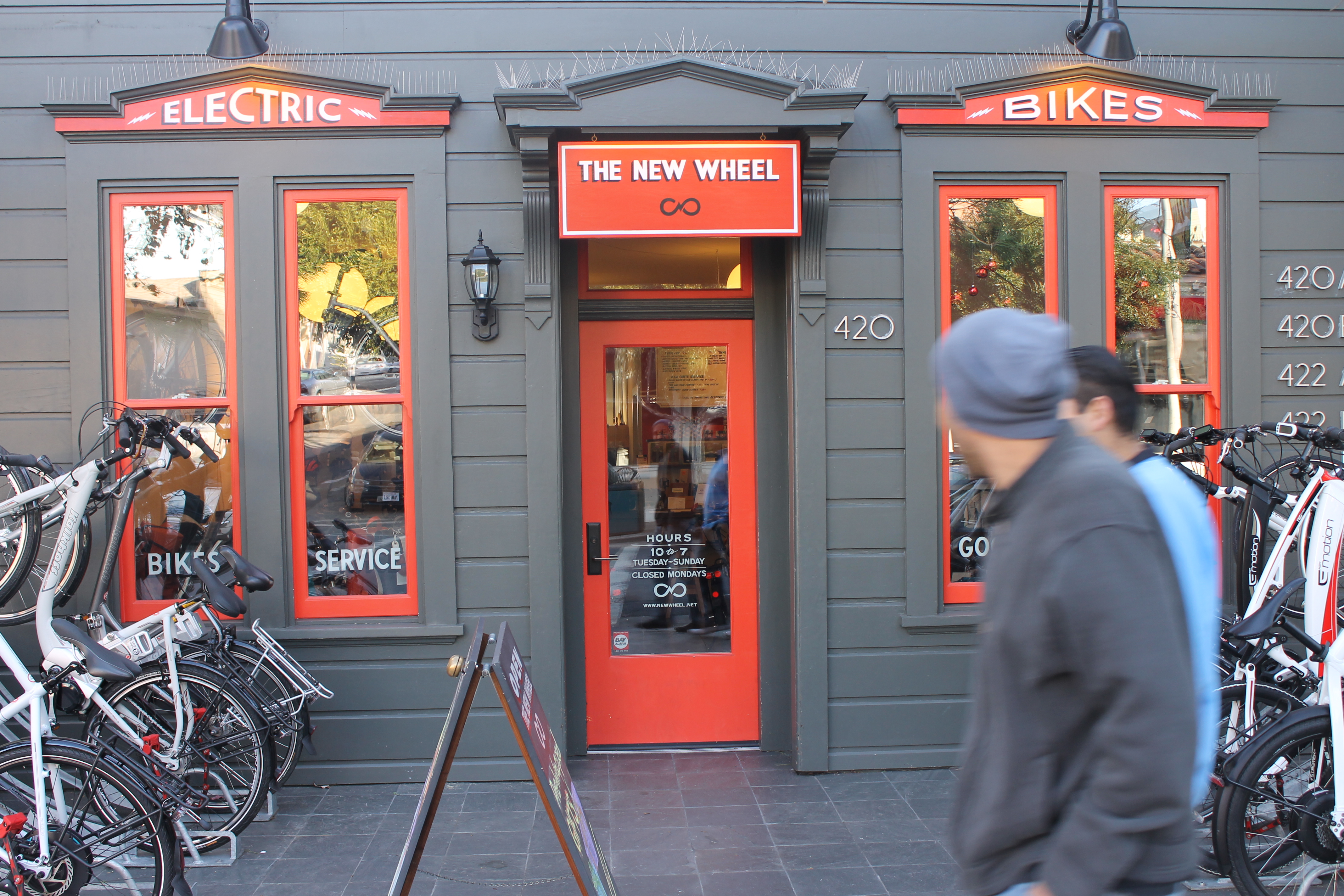As I wrote earlier, I love living without a car. Also, I just bought a car. It sits in our driveway, blocking the access to the shed where we keep our bikes. I should say, my wife Beth keeps her bike in the shed. A thief took mine.
And what a bike it was. It was a Bianchi Brava, lightweight, fast, and sexy. I loved the way it looked, the way it lifted easily to my shoulder to leave the subway, the way it leapt forward when I put some muscle behind the pedals. Here, behold:
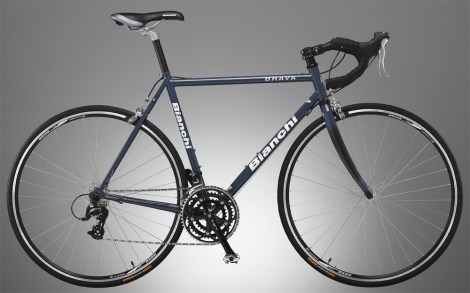
The dearly departed.
Well, that’s what it looked like when I bought it. Then I added a rack. Next I put on a child’s seat. By the time it was stolen, I was window-shopping for baskets and fenders.
Perhaps its disappearance was a blessing in disguise: I don’t need a speedy road bike anymore. I need a dad bike, something that will allow me to schlep babies and groceries — and get me out of that infernal car. So that’s my quest: Find the dad bike that will make our car obsolete.
Here are my criteria:
1. Functionality: It’s got to convey me, two kids, groceries, etc. around town more conveniently than a car. It’s got to keep me clean and should deliver me looking presentable.
2. Reliability: It shouldn’t need much maintenance to last for at least a decade.
3. Size: It should be fairly small, as I don’t have much space for storage.
4. Joy: It should feel good to ride, and, if possible, it should be a thing of beauty.
5. Price: I’m willing to shell out some ducats. This is going to be my main form of transportation and I expect the investment to pay off (as I save on gas, parking tickets, and repairs) in the long run.
I started out by looking at cargo bikes and bakfiets — a Dutch breed of bicycle with a big box in front. You can pile all manner of kids, dogs, toys, kayaks, and furniture (seriously!) into these things. Here’s one:
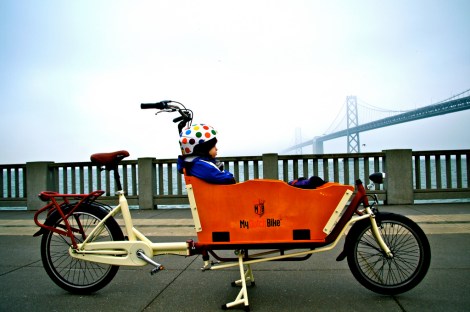
twotoneatlBakfiet.
But cargo bikes also have problems. They are big and we don’t have much space. And it doesn’t look like much fun to ride one when loaded: “Super tippy and intense,” is how a friend described the experience. It was a bit too tippy just balancing a single kid in a rear child seat on my Bianchi — I had some close calls while parking.
So cargo bikes were out, but there was another solution sitting right in our shed: We already have a trailer for Beth’s bike. It’s pretty roomy — you can throw a couple bags of produce in there with a kid — but it folds up and stows nicely. I was nervous about trailers at first: I worried that the low profile would put them in constant danger of being run over. But it turns out that bike-mounted seats are at least as dangerous as trailers. And unlike with a child seat, a trailer doesn’t fall over, even if you do.
I went ahead and bought an extra hitch so I could pull Beth’s trailer. Now I just needed a bike with which to pull it.
A dad bicycle, I decided, should have a geometry of safety, rather than speed. When I’m on a fast bike, I’m tempted to race the other riders at every green light. Instead of an aggressively high seat and a racer’s drop handlebars, I should be shopping for a bicycle that put me in an upright position — poised for appreciation, rather than competition. I’d be looking for an easy, unpretentious step-through frame so I wouldn’t have to throw my leg over the crossbar while balancing a heavy load in back. Sure, this is what you probably think of as a “lady’s” bike, but aren’t we past that by now? And by the way, as someone who fell on that high “men’s” crossbar more than once when I was a kid, isn’t it a cruel irony to force the testicle-busting version of the bicycle on boys?
I imagined myself pedaling around town on a sleek European bike, my daughter behind in the trailer, a loaf of bread in the front basket, bags of produce in the panniers … The imaginary Nate on the bicycle was starting to sweat. If I was going to give up the efficiency of a road bike, and add weight, I might need some help.
I spent that evening looking at pedal-assist motors for bikes. The ones I found were pretty clunky: The batteries fit awkwardly in the geometry of the frames. It was hard for me to tell where the line was between cheapness and luxury. The next morning, I called an electrical bike shop in San Francisco called The New Wheel, and asked for help. The woman who picked up the phone explained that the bikes were even more expensive than I thought.
“I wouldn’t recommend buying one that’s under $2,000,” she said.
That’s because the cheap ones are made in China, and it’s extremely hard to buy replacement parts if something breaks. Despite the sticker shock, she persuaded me to come into the shop and take a test ride. Maybe the bikes wouldn’t look so clunky in person.
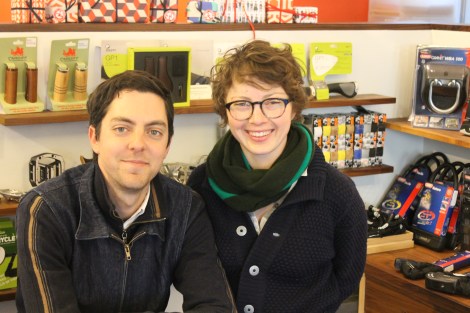
Brett and Karen, proprietors of The New Wheel.
The person I’d talked to turned out to be Karen Wiener, who opened the shop with her husband Brett Thurber. They steered me toward a bike made by the German company Kalkhoff, and I took it for a spin. It felt remarkably awkward at first. The bike had internal gears which means you’re supposed to shift when you aren’t pedaling, which is just the opposite of a conventional bike. The motor added power to my pedaling, but when I tried to push harder and speed things up it almost felt as if I was working against the motor.
It turned out the motor had nothing to do with it, I just wasn’t used to the upright posture, or to riding such a heavy bike. The trick, Brett told me, was to pedal casually and let the motor push you. Before I knew it I’d reached the top of Bernal Hill. It was effortless, so effortless that it didn’t feel like what I thought of as cycling.

Hill? What hill?
When I’d entered the shop I’d met a couple, Tera and Bob Wattles, who had brought their bikes in for a tune up. Tera said she’s always cycled, but “as you get older, toward 70, it’s harder to keep up.” The motor assist is the solution, she told me.
“I just love passing the young guys with all the fancy gear,” she said with a chuckle. “They can’t stand it.”
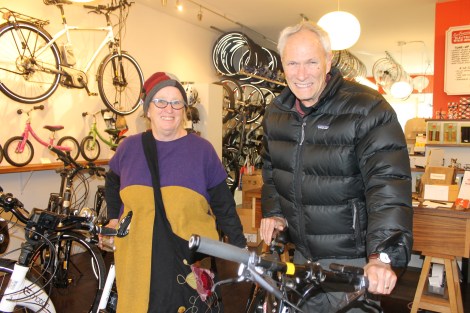
Tera and Bob Wattles.
This, ultimately, is the point. I’d like bicycling to be a mode of transportation for regular folks, rather than just a plaything for the middle-aged men in lycra, or MAMILs. If my dad bike is truly going to outcompete the car, it can’t be a struggle. It just won’t work if there are some daily errands that require extraordinary exertion. That makes me think I should spring for an electric bike.
On the other hand my test ride taught me that I might miss feeling of my bicycle efficiently converting muscular effort into speed. I don’t want to buy a scooter. Then there’s the issue of aesthetics. I’d imagined buying a graceful European-style bike, not a big beast. But battery packs ruin the elegant lines of those bikes in my eyes. I could buy a Faraday Porteur, the first beautifully designed electric bike I’ve seen, but it’s too large an investment for me to risk first-generation glitches: For something just south of $4,000 I’d need to be sure it was going to last.
As I close here, I’m still looking around, and I could use a little help. I could get a heavy, homely, uber-reliable electric Kalkhoff for around $3,000. Brett assures me that I’d love the way it feels once I got the hang of it.
Or I could opt for something less expensive and more beautiful, without the pedal assist. But I’m not sure what that something would be: I’ve had a hard time finding an upright, step-through frame that’s big enough for me (I’m 6’5″). If anyone out there has suggestions, I’d love to hear them. I’d be willing to spend $1,700, ideally with an internally geared hub, or at least a chain guard, to keep my pants clean. A mixte frame would work too.
I’ll have to make a decision soon: The car is running low on gas, which means that, for the first time in four years, I’m going to have to buy fossil fuel for my daily transportation. My last car just about squeezed me dry before I broke its thrall; not this time. Live car-free or die! OK maybe that sets the stakes too high. So, ahem: Give me car-freedom or give me public humiliation!
Here’s the conclusion of this quest.

